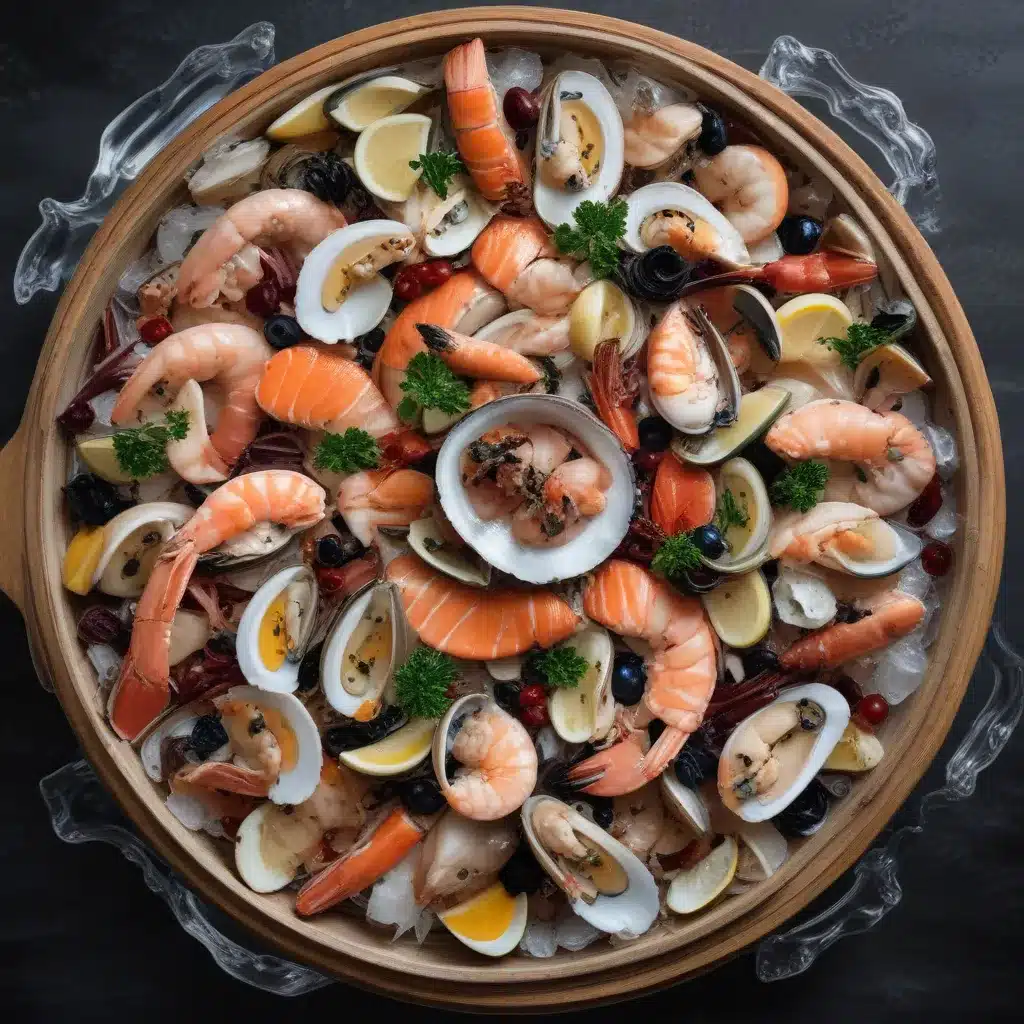
As a seafood dining expert writing for Fish Tales Cafe, I’m excited to share my insights on enhancing your seafood experience through proper storage techniques and thoughtful wine pairings. Whether you’re indulging in delicate white fish, succulent shellfish, or robust oily varieties, understanding the nuances of seafood flavor profiles and storage best practices can elevate your culinary journey.
Seafood Storage Considerations
Proper seafood storage is paramount in maintaining the freshness, texture, and flavor of your catch. Let’s explore the key principles to ensure your seafood remains at its peak.
Proper Refrigeration Techniques
When it comes to storing fresh seafood, temperature control is crucial. Cod, halibut, tuna, and other delicate white fish varieties should be kept at or below 40°F (4°C) to inhibit bacterial growth and preserve their delicate flavors. Oily fish like salmon, mackerel, and sardines require even colder temperatures, ideally between 32-34°F (0-1°C), to prevent oxidation and rancidity.
Shellfish, such as oysters, clams, and mussels, thrive in a humid environment with temperatures hovering around 35-40°F (2-4°C). Proper storage in a perforated container or wrapped in damp towels can extend their shelf life by several days.
Temperature and Humidity Control
Maintaining the optimal balance of temperature and humidity is key to maximizing the storage life of your seafood. Invest in a reliable refrigerator or dedicated seafood cooler that can precisely regulate the environment. Avoid fluctuations in temperature, as these can lead to degradation and undesirable textural changes.
Shelf-Life Maximization
Understanding the expected shelf life of different seafood varieties can help you plan your meals and minimize waste. For example, cod and other white fish maintain their quality for 3-5 days when properly refrigerated, while salmon and other oily fish may last 2-3 days. Shellfish, on the other hand, should be consumed within 1-2 days of purchase for optimal freshness.
Seafood Flavor Profiles
Exploring the unique flavor profiles of various seafood types is essential for creating harmonious pairings with complementary wines.
Delicate White Fishes
Mild-flavored white fish like cod, halibut, sea bass, and sole often possess a delicate, sweet, and subtly briny essence. Their light, flaky textures make them excellent candidates for sous vide preparations or en papillote (baked in parchment paper) cooking methods that preserve their natural flavors.
Oily Fish Varieties
In contrast, salmon, mackerel, sardines, and tuna belong to the oily fish family. These varieties boast a more robust, sometimes slightly umami-forward taste and a richer, more buttery mouthfeel. Their fattier composition lends well to grilling, pan-searing, or smoking techniques that complement their bold flavors.
Shellfish Nuances
Shellfish, such as oysters, clams, mussels, and scallops, offer a spectrum of flavors ranging from briny and oceanic to sweet and delicate. The nuanced taste profiles of these marine delicacies can be further enhanced through mignonette sauces, zesty ceviche preparations, or simply savored on their own.
Sommelier’s Pairing Principles
Mastering the art of pairing seafood with the perfect wine requires a deep understanding of both flavor profiles and the principles of wine and food harmony.
Wine Acidity and Seafood
The high acidity found in many white wines, such as Sauvignon Blanc, Albariño, and Vermentino, pairs exceptionally well with seafood. The wine’s crisp, refreshing characteristics help to cut through the richness of oily fish and cleanse the palate, preparing it for the next delectable bite.
Complementary Flavor Matching
Seek out wines that echo the flavor notes present in your seafood dish. For example, a Chardonnay with subtle oak influence can complement the buttery undertones of halibut or sea bass, while a Riesling with its citrus and mineral qualities can elevate the briny essence of oysters or clams.
Texture Harmony
In addition to flavor profiles, consider the textural interplay between your seafood and wine. A Pinot Grigio or Picpoul de Pinet with its light, crisp mouthfeel can harmonize beautifully with delicate cod or sole, while a more full-bodied Verdicchio or Viognier can stand up to the robust texture of salmon or tuna.
Optimal Serving Recommendations
Thoughtful presentation and serving techniques can further enhance the overall dining experience.
Plating and Presentation
Arrange your seafood dishes with an eye for visual appeal. Consider the contrasting colors, textures, and shapes of your ingredients to create visually striking plates. Garnish with fresh herbs, citrus, or edible flowers to add a touch of elegance.
Garnishes and Accompaniments
Carefully selected garnishes and accompaniments can elevate your seafood dishes. A mignonette sauce, with its blend of vinegar, shallots, and black pepper, can complement the brininess of oysters. A zesty ceviche marinade can enhance the natural flavors of halibut or sea bass. And a vibrant salsa verde or beurre blanc can bring out the richness of salmon or tuna.
Serving Temperatures
Maintaining the optimal serving temperature is crucial for preserving the delicate flavors and textures of your seafood. Delicate white fish and shellfish are best enjoyed chilled, around 45-50°F (7-10°C), while oily fish can withstand slightly warmer temperatures, around 55-60°F (13-16°C).
By mastering the art of seafood storage, understanding flavor profiles, and applying the principles of wine pairing, you can elevate your seafood dining experience to new heights. Pair your expertly prepared seafood with the perfect wine selection, and let your palate be transported to the depths of culinary delight. Visit Fish Tales Cafe to explore our curated menu and discover the unparalleled joy of seafood paired with wine perfection.

